Exploring Neurological Disorders and Brain Health
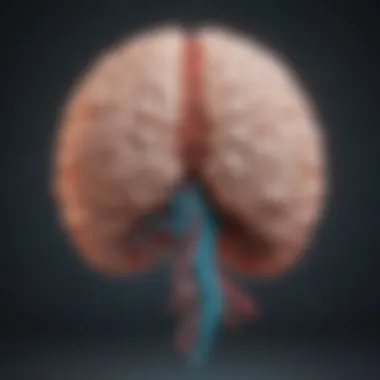
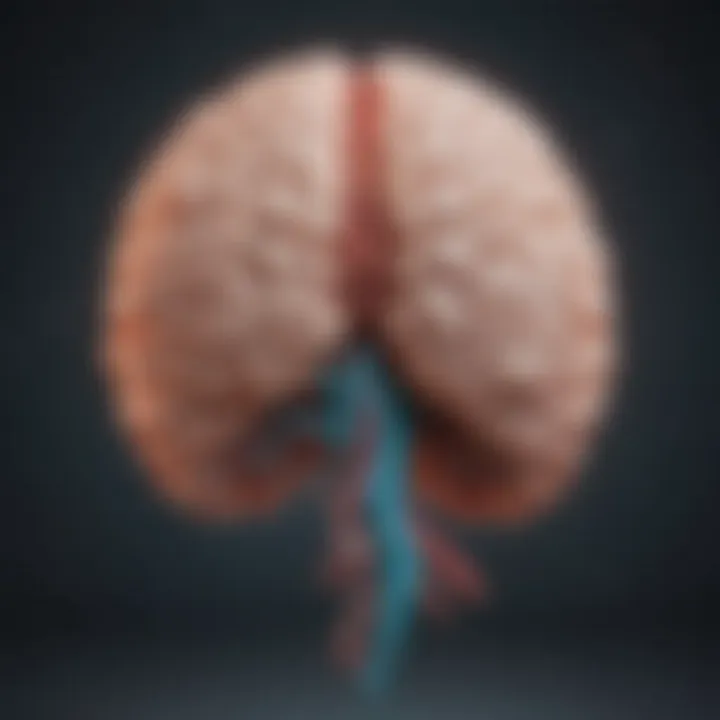
Intro
The human brain is an organized mess of neurons, synapses, and chemicals that govern our thoughts, feelings, and actions. Despite being the most complex organ in the body, it can experience a variety of disorders that challenge both its structure and function. Understanding these brain illnesses goes beyond merely scratching the surface; it requires diving into the intricate labyrinth of pathways and systems that can lead to debilitating conditions.
In this article, we will navigate through the intriguing realm of neurological disorders, their classifications, and how they impact those who live with them. We will explore both neurodevelopmental and neurodegenerative disorders, shedding light on the myriad of symptoms and treatment options available today. By unpacking fresh research findings and diagnostic methodologies, we aim to enhance awareness of the importance of brain health and foster a deeper understanding of how these illnesses shape personal and societal experiences.
Background and Context
Overview of the research topic
When discussing neurological disorders, one might feel as though they’re standing on the edge of a vast and varied ocean. Each wave represents a different disorder, ranging from autism spectrum disorders and ADHD to Alzheimer’s disease and multiple sclerosis. This topic is of particular importance today as the prevalence of mental health issues has soared in recent years. Targeting the neurological underpinnings of these conditions can lead clinicians to better treatment paths.
Historical significance
The journey to comprehend brain illnesses has been a rollercoaster ride filled with groundbreaking discoveries and sometimes profound missteps. Early understandings were often steeped in superstition and vague theories. It wasn’t until the establishment of the neuron doctrine in the late 19th century that a more coherent picture began to emerge. Scientists like Santiago Ramón y Cajal paved the way for modern neuroscience through rigorous research on brain structure, while Carl Jung and Sigmund Freud laid the groundwork for addressing psychological disorders. These figures and their work represent critical milestones in our understanding of the mind and body connection.
"The greatest discovery of my generation is that a human being can alter his life by altering his attitude." - William James
The evolution of neuroscience has also paved the way for a multitude of practices aimed at diagnosis and treatment. From brain imaging technologies, like fMRI, to advances in pharmacology that target specific neurotransmitter systems, the realm of neurological disorder research has broadened significantly. Each stepping stone on this path has contributed to an overall deeper comprehension of the brain’s complexity and the various factors that can interfere with its function.
As we progress, it’s essential to keep in mind the many facets of brain illnesses. From genetic predispositions to environmental triggers, these disorders often arise from a combination of interrelated factors. The risks cannot be understated; understanding these complexities not only promotes better individual awareness but also highlights the necessity for continual support in research efforts that seek to fathom the depths of brain health.
Next, we will delve into the key findings and discussions that provide a more detailed look at both the potential and challenges associated with treating neurological disorders.
Overview of Brain Illnesses
Brain illnesses encompass a broad spectrum of disorders that affect the functioning of the brain, ranging from congenital issues to those that develop over time. Understanding these illnesses is pivotal not just for medical practitioners but for families, educators, and society at large. An informed society can better support individuals suffering from neurological conditions and foster a more empathetic approach toward their challenges.
Defining Brain Illnesses
To grasp the complexities of brain illnesses, one must first define what constitutes these disorders. Brain illnesses generally refer to any condition that disrupts normal brain function. This can include anything from neurodevelopmental disorders like autism spectrum disorder to neurodegenerative diseases such as Alzheimer’s. They can arise due to various factors, including genetic predispositions, environmental exposures, and traumatic experiences. Typical symptoms may include cognitive disruptions, mood swings, and changes in behavior.
A salient aspect is how these illnesses manifest differently in each individual. For example, the same diagnosis can lead to varied symptoms based on age, sex, and even cultural background.
Historical Perspectives
The historical context of brain illnesses reveals a evolving understanding that parallels technological advancements. In ancient times, brain conditions were often attributed to mystical forces or demonic possession. Treatments ranged from rituals to trepanation—drilling holes in the skull. The Greek physician Hippocrates was among the first to propose a physiological basis for these disorders, though his notions were rudimentary by today’s standards.
By the 19th century, breakthroughs like the discovery of the neuron established the foundation for what we now understand about brain functioning. The advent of neuroimaging in the late 20th century transformed diagnostics and treatment approaches dramatically. Technologies like MRI (magnetic resonance imaging) and PET (positron emission tomography) allow researchers to visualize changes in brain structure and activity, providing insights that were once unimaginable.
Over the decades, the conversation around brain illnesses has shifted from purely physiological perspectives to include psychological, social, and environmental dimensions, reflecting a more holistic understanding.
"To treat brain illnesses effectively, one must view them through a multifaceted lens, encompassing biological, psychological, and social factors."
Recognizing the history of brain illnesses lays the groundwork for appreciating current challenges and recognizing the progress made in research and treatment. As research progresses, it increasingly highlights the necessity for interdisciplinary approaches to tackle these complex disorders.
Classification of Brain Disorders
The classification of brain disorders serves as a fundamental framework for understanding varied conditions that affect the brain's functionality and structure. It plays a vital role in the clinical, educational, and research contexts, helping to categorize disorders based on shared characteristics. This systematization allows for better diagnostic protocols, appropriate treatment methodologies, and tailored interventions for individuals affected by neurological conditions.
Understanding the classification also provides insights into the relationship between specific symptoms and underlying pathologies. Furthermore, it allows researchers to track prevalence, identify risk factors, and investigate potential genetic and environmental influences that might lead to these disorders. Ultimately, well-organized classifications contribute to enhanced awareness in society, fostering informed discussions about brain health.
Neurodevelopmental Disorders
Neurodevelopmental disorders form a significant segment in the classification of brain illnesses. These disorders occur during the early stages of brain development and can affect learning, behavior, and overall functioning. Conditions such as Autism Spectrum Disorders, Attention Deficit Hyperactivity Disorder (ADHD), and Learning Disabilities all fall under this category.
These conditions can vary widely, from mild to severe, and may not be instantly recognizable. They may manifest in childhood and can persist into adulthood, influencing educational achievements, social interactions, and daily living skills. Interventions can be structured to meet individual needs, typically focusing on behavioral therapies, educational support, and sometimes medication. The understanding of neurodevelopmental disorders is critical as it lays the groundwork for timely interventions that can significantly enhance quality of life.
Neurodegenerative Diseases
In contrast, neurodegenerative diseases are progressive disorders that lead to the degeneration of nerve cells, often causing a decline in cognitive function or motor abilities. Alzheimer’s disease, Parkinson’s disease, and Amyotrophic Lateral Sclerosis (ALS) are prominent examples that illustrate the profound impact on individuals' lives.
Neurodegenerative diseases often develop later in life and can vary in terms of symptoms and severity. They generally require a comprehensive management plan which may integrate pharmacological treatments to alleviate symptoms, along with psycho-social support for patients and caregivers alike. Advancements in research are continually uncovering more about the mechanisms behind these diseases, thus improving potential treatment options and methods for managing patient care.
Acquired Brain Injuries
Acquired Brain Injuries (ABIs) occur due to external factors such as trauma, stroke, or infections like meningitis. This category encompasses a wide range of injuries that can have lasting effects on a person's cognitive, physical, and emotional functioning. Traumatic Brain Injury (TBI), for example, often results from accidents, while strokes can dramatically compromise brain function depending on the area affected.
Recovery can be an arduous process requiring rehabilitation that focuses on restoring skills and adapting to new circumstances. Understanding the vast array of potential outcomes surrounding ABIs is essential for tailoring rehabilitation strategies and maximizing recovery potential.
Psychiatric Disorders
Psychiatric disorders represent another critical classification, often overlapping with neurological disorders. Conditions like Major Depressive Disorder, Bipolar Disorder, and Schizophrenia can stem from neurobiological disruptions that lead to significant emotional distress and behavioral challenges.
These disorders may display physical indicators in brain structure and function yet are often treated through a combination of psychotherapy and pharmacological approaches. Effective treatment plans require a solid understanding of each condition's nuances, taking into consideration both the biological and psychosocial context of the individual affected. This holistic view is imperative in navigating the complexities inherent in psychiatric disorders.
Understanding the classification of brain disorders not only informs treatment protocols but also facilitates critical dialogue surrounding prevention and research. Each category offers unique insights, emphasizing the need for continued exploration and support in addressing brain health challenges in our society.
Neurodevelopmental Disorders
Neurodevelopmental disorders play a significant role in our understanding of brain illness. These disorders, which manifest during the development of the nervous system, can affect behavior, intellectual ability, and learning capacities. Recognizing this importance is key, as it sheds light on how these conditions not only impact individuals but also ripple through families and society.
The earlier these disorders are identified, the better the chances of effective intervention and management. They affect not just one’s cognitive abilities but can also have profound social implications, making awareness and understanding crucial. Moreover, the classification of these disorders helps professionals tailor their approach, enhancing the quality of life for those affected.
Autism Spectrum Disorders
Autism Spectrum Disorder (ASD) is one of the most widely recognized neurodevelopmental disorders. It is characterized by challenges with social skills, repetitive behaviors, and communication. The spectrum metaphor reflects the wide range of symptoms and behaviors present in individuals with autism. One person may have significant struggles in verbal communication but excel in math, while another may not show any clear special skills yet face challenges in social situations.
Interventions often hinge on early diagnosis. Families frequently seek behavioral therapy and educational support to help their children navigate daily challenges. As the understanding of autism evolves, there’s also increasing recognition of the need for support across the lifespan, addressing needs even into adulthood.
"Understanding is the first step to acceptance, and only with acceptance can there be recovery." - J.K. Rowling
Attention Deficit Hyperactivity Disorder (ADHD)
Attention Deficit Hyperactivity Disorder is another prevalent neurodevelopmental condition, typically manifesting in early childhood. Characterized by inattention, hyperactivity, and impulsiveness, ADHD can interfere with functioning in various settings including school, home, and social interactions.
What sets ADHD apart is the variability in its presentation among individuals. While some may seem to have boundless energy and struggle to concentrate, others might appear quiet yet be wrestling with focus issues. Awareness of these differences is vital for effective management. Natural remedies, tailored educational plans, and behavioral strategies can combine to create a rounded approach to management.
Learning Disabilities
Learning disabilities are complex disorders that affect the brain’s ability to absorb, process, and communicate information. They aren’t a reflection of intelligence; rather, an individual with a learning disability may have average or even above-average intellect but struggle with specific subjects such as reading, mathematics, or writing.
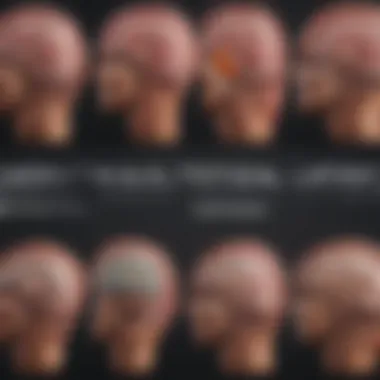
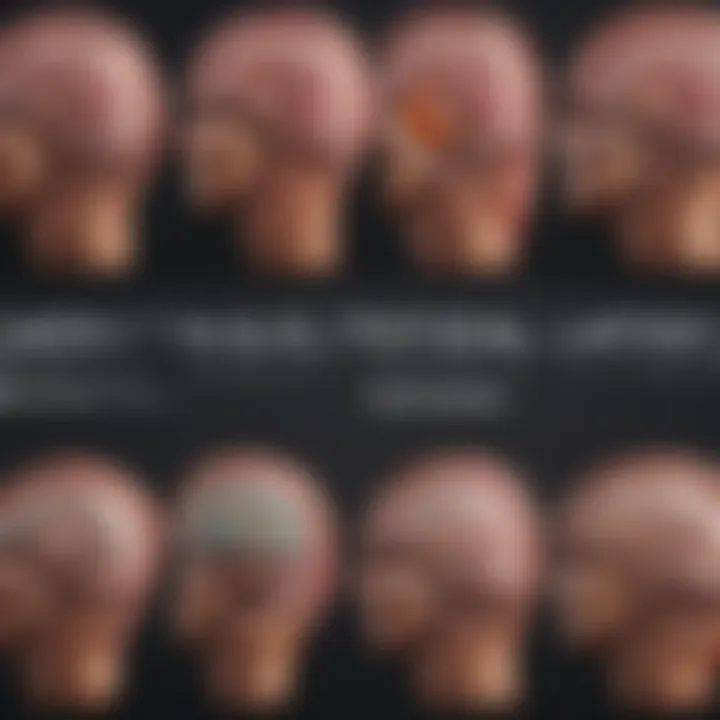
For example, dyslexia specifically affects reading abilities; individuals may face challenges with word decoding or spelling. Recognizing these difficulties early on can lead to specialized instruction techniques to provide support, allowing individuals with learning disabilities to succeed academically and beyond. Schools often play a crucial role in constructing personalized education plans that cater to the unique needs of students with these disabilities.
Neurodegenerative Diseases
Neurodegenerative diseases represent a significant area of concern within the realm of brain illnesses. These conditions are characterized by the progressive degeneration of the structure and function of the nervous system, often leading to profound impacts on physical abilities and cognitive functions. The importance of studying these diseases is underscored by their prevalence and the challenge they pose to both individuals and the healthcare systems that support them.
Understanding neurodegenerative diseases illuminates the mechanisms at play within the human brain, which can guide researchers and medical professionals towards more effective interventions. Moreover, these insights can foster a deeper appreciation of the aging process and the various factors that may contribute to neurological decline. For that reason, they offer both a scientific and a personal dimension, merging the biological with the lived experience of countless families.
Alzheimer’s Disease
Alzheimer's Disease is one of the most recognized neurodegenerative conditions, affecting millions worldwide. It primarily impairs memory and cognitive function, progressively stealing away the individual's ability to work and interact socially. The hallmark symptoms, such as forgetfulness and confusion, often begin subtly, making early detection a daunting task.
A closer look at the underlying causes reveals a complexity that ranges from genetic predispositions to lifestyle-related factors. The accumulation of amyloid plaques and tau tangles profoundly disrupts normal brain function, leading to cell death and brain shrinkage. While the scientific community is engaged in ongoing battles to unravel this complexity, some potential pathways for prevention and treatment are also being explored. For instance, engaging in regular physical activity, maintaining a balanced diet, and keeping one’s mind active may offer some protective benefits.
"Most Alzheimer’s patients are in their 70s or 80s, but early-onset cases can arise as early as in their 30s or 40s."
Parkinson’s Disease
Parkinson’s Disease, another well-known neurodegenerative disorder, is marked by motor symptoms such as tremors, rigidity, and bradykinesia—slowness of movement. Unlike Alzheimer's, which primarily impacts cognition, Parkinson’s primarily affects movement, creating challenges that can lead to serious complications if not managed properly.
The condition results from the loss of dopamine-producing neurons in the brain, specifically in the substantia nigra. These neurons play a crucial role in controlling movement and coordination. This degeneration manifests not only physically but also often leads to psychological effects, including depression and anxiety. Continued research is shedding light on potential therapies that include both pharmacological treatments, such as levodopa, and lifestyle adjustments that may improve quality of life.
Amyotrophic Lateral Sclerosis (ALS)
Amyotrophic Lateral Sclerosis, often referred to as ALS, is a particularly devastating neurodegenerative disorder, as it leads to the progressive degeneration of motor neurons. This results in muscle weakness, paralysis, and, ultimately, death, usually within three to five years from diagnosis. Unlike other conditions, ALS can strike unexpectedly, typically during middle age, with no clear obvious risk factors.
While the precise cause remains elusive, researchers have identified a mix of genetic components and environmental triggers that might play a role in its onset. The struggle of those affected by ALS has garnered significant attention within the scientific community. A variety of treatments are currently being investigated, from pharmacological agents like riluzole to cutting-edge gene therapies aiming to halt the course of the disease.
Acquired Brain Injuries
Acquired brain injuries (ABIs) represent a poignant area of study within the broader context of neurological disorders. Unlike congenital conditions, these injuries are not present at birth but occur due to circumstances that disrupt normal brain function. Understanding ABIs is crucial as they often lead to profound changes in an individual's life, affecting cognition, mobility, and emotional regulation. Thus, diving into this topic sheds light on multiple dimensions of human experience – from the personal struggles faced by individuals to the broader societal implications.
Traumatic Brain Injury (TBI)
Traumatic brain injury stands as one of the leading causes of death and disability globally. A TBI occurs when an external force causes injury to the brain. This could be the result of a fall, vehicular accident, or even an assault. The severity of TBI can range from mild concussions to severe brain damage, and it changes lives in unimaginable ways.
- Common Symptoms Include:
- Headaches
- Confusion
- Dizziness
- Memory loss
With the increase in sports and recreational activities, the prevalence of TBI has surged. Notably, awareness of its effects has grown, prompting initiatives aimed at prevention and better management of the aftermath. The importance of helmet use in sports—and even in cycling—serves as a testament to the necessity of protective measures.
The journey through recovery from a TBI is often a daunting one. Individuals might require extensive rehabilitation, and many face long-term challenges. It's a stark reminder of the resilience of the human spirit and the importance of societal support in the healing process.
Stroke and Its Consequences
Stroke emerges as another significant form of acquired brain injury, where blood flow to an area of the brain is interrupted or reduced, preventing brain tissue from receiving oxygen and nutrients. The consequences can be devastating, often leading to lasting impairments in speech, mobility, and even cognition. Types of strokes include ischemic, caused by a blockage, and hemorrhagic, stemming from bleeding in the brain.
Understanding the aftermath of strokes is key, as the recovery process can be extensive and unpredictable. Rehabilitation may include physical, occupational, and speech therapy. Here are important points to consider about stroke recovery:
- Early detection is crucial.
- Family support plays a vital role in recovery.
- Lifestyle changes can impact long-term health outcomes.
"A stroke can change the course of a life in mere minutes; understanding the mechanisms is critical for timely intervention."
Infections and Meningitis
Infections can also lead to acquired brain injuries, with meningitis being a prime example. Meningitis is the inflammation of the protective membranes covering the brain and spinal cord, usually caused by infection. The impact of meningitis can be profound, sometimes leading to brain damage, hearing loss, or even death.
Prompt diagnosis and treatment are essential in mitigating the risks associated with meningitis. Common symptoms often include headaches, fever, and neck stiffness. Here are steps taken during an infection:
- **Diagnosis often involves:
- **Treatment options may include:
- Lumbar puncture to examine cerebrospinal fluid.
- Blood tests to identify pathogens.
- Antibiotics for bacterial meningitis.
- Supportive care for recovery.
Rather than merely examining symptoms, it’s vital to focus on preventative measures within communities. Vaccines, awareness campaigns, and health education serve as frontline defenses against infections leading to acquired brain injuries.
Psychiatric Disorders
The study of psychiatric disorders is paramount in understanding brain illnesses. These disorders not only affect the individual's mental health but can also have a cascading impact on their personal and social lives. The complexity surrounding psychiatric conditions calls for a delicate examination of various factors, from genetic predispositions to environmental triggers. Key elements in this discussion include the significance of early identification, the role of stigma, and divergent treatment strategies that have emerged over the years.
Apart from the personal implications, psychiatric disorders contribute significantly to healthcare costs and societal issues, making them a crucial area of research and awareness. Given the intricate nature of the human brain, comprehending these disorders is vital not only for academic purposes but also for practical applications in mental health support and rehabilitation.
Major Depressive Disorder
Major Depressive Disorder (MDD) is a profound illness, recognized by persistent feelings of sadness and a lack of interest in life activities. Affecting millions worldwide, MDD manifests in many forms with symptoms ranging from deep melancholy to severe disruption in daily functioning. The National Institute of Mental Health estimates that around 8.4% of the adult population experiences MDD in any given year.
Factors contributing to MDD include:
- Genetics: A family history of depression can increase one’s risk.
- Biochemistry: Changes in brain chemistry and hormone levels can influence mood.
- Environmental Stressors: Situational pressures such as trauma, loss, or other emotional stresses can trigger depressive episodes.
MDD not only carries significant emotional burdens but can also prompt other health complications such as cardiovascular diseases. Effective treatments typically combine pharmacological interventions, such as antidepressants, with psychotherapeutic approaches like cognitive behavioral therapy (CBT).
Bipolar Disorder
Bipolar Disorder is characterized by extreme mood swings, including emotional highs (mania or hypomania) and lows (depression). These fluctuations can disrupt an individual's life significantly, often complicating personal and professional relationships. The course of the disorder varies widely; some individuals may experience rapid cycling between moods, while others might have longer intervals between episodes.
A few notable aspects of Bipolar Disorder:
- Types of Episodes: The disorder is classified into Bipolar I, II, and cyclothymic disorder, each with unique patterns of mood swings.
- Triggers: Stressful events, seasonal changes, or changes in sleep patterns can trigger episodes.
- Treatment Approaches: Managing Bipolar Disorder often requires mood stabilizers, lifestyle modifications, and psychoeducation to promote awareness about the condition.
Understanding this disorder is key to reducing stigma and improving patient outcomes through targeted educational initiatives and community support.
Schizophrenia
Schizophrenia is a severe mental health disorder marked by disruptions in thought processes, perceptions, emotional responsiveness, and social interactions. Affected individuals may experience hallucinations, delusions, and cognitive challenges, leading to a considerable impact on their daily lives. It’s estimated that about 1% of the global population is affected by schizophrenia, with onset typically occurring in late adolescence or early adulthood.
Important elements regarding Schizophrenia include:
- Symptoms Classification: Positive symptoms include hallucinations and delusions, while negative symptoms involve a reduction in emotional expression and motivation.
- Causes: A combination of genetic, brain chemistry, and environmental factors appears to contribute to its onset, though the precise cause remains unresolved.
- Management Strategies: Treatment typically involves antipsychotic medications, psychosocial therapies, and support services to help manage symptoms and facilitate recovery.
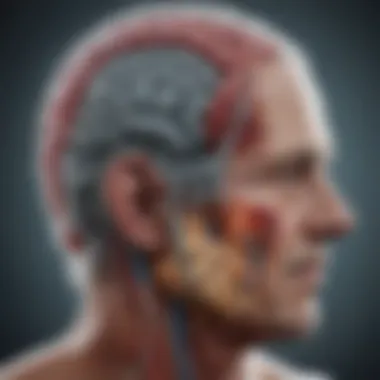
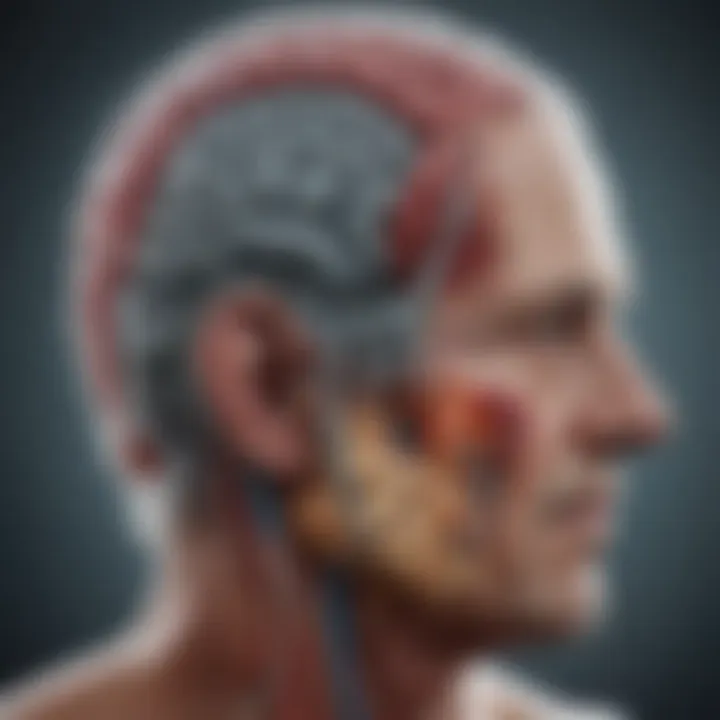
The complexities surrounding schizophrenia underscore the importance of ongoing research in understanding the neurobiological underpinnings and developing more effective therapeutic interventions.
"Mental disorders are no joke, affecting not just individuals but also families and communities. Raising awareness and understanding can pave the way for better support systems."
Understanding these psychiatric disorders is crucial for improving quality of life for those affected and for fostering an environment that prioritizes mental well-being in society.
Mechanisms Behind Brain Illnesses
Understanding the mechanisms that contribute to brain illnesses offers crucial insights into both the origins and progression of these disorders. Grasping the complex interplay of genetic, environmental, and vascular factors aids in crafting effective treatments. This knowledge is not just an academic pursuit; it has real-world benefits for affected individuals, healthcare providers, and researchers alike. Knowing how each element plays a role can enhance diagnosis and treatment offerings, ultimately improving patient outcomes.
Genetic Factors
Genetic influences on brain illnesses are vast and multifaceted. Various illnesses, such as Alzheimer’s disease, have been linked to specific genes like APOE. Individuals with certain genetic profiles may be predisposed to these conditions, though genetics don’t operate in isolation. Instead, they interact with various environmental factors, shaping the overall risk of developing a disorder.
- Genetic markers provide vital clues, helping researchers understand how disorders can manifest and evolve.
- Family history can act as a telltale sign, hinting at potential vulnerabilities among relatives.
- Research has shown that even common conditions, such as ADHD, have a genetic component, influencing behavior and learning styles.
However, it's worth noting that genetics is but one piece of a larger puzzle. While a genetic predisposition may exist, it does not guarantee the onset of an illness. Rather, it informs a potential pathway that could lead to further study and preventive measures.
Environmental Influences
The environment plays an equally significant role when it comes to brain disorders. Factors such as exposure to toxins, lifestyle choices, or even socio-economic status can dramatically sway mental health outcomes. For instance, urban environments have been studied for their impact on mental health due to factors like noise pollution and limited access to green spaces.
- Stressful life events can act as triggers for psychotic disorders in those already at risk.
- Maternal health, including nutrition and exposure to pollutants during pregnancy, factors heavily into neurodevelopmental conditions in children.
- Childhood trauma or neglect has been associated with long-term psychological issues, emphasizing the importance of early intervention.
Creating awareness around these environmental risks can empower communities to take proactive measures in protecting mental health. Educational programs aimed at children about stress management and coping mechanisms are essential in mitigating adverse outcomes stemming from environmental stressors.
Vascular Contributions
Vascular health directly correlates with brain function, influencing several disorders. For instance, strokes—whether ischemic or hemorrhagic—can have immediate and long-lasting consequences for cognitive function. The interplay of blood flow to the brain is crucial; conditions like hypertension can lead to brain lesions, affecting cognitive abilities over time.
- Good vascular health can support healthier brain function, possibly reducing the risk of neurodegenerative diseases.
- Recognizing the signs of poor vascular health, like high cholesterol, is key to preventing related brain disorders.
- Exercise and diet, which promote better vascular conditions, can also have beneficial effects on cognition and memory retention.
In summary, the mechanisms behind brain illnesses are a wellworn compass guiding researchers and healthcare professionals through the complex landscape of neurological disorders. A multifaceted approach, incorporating genetic, environmental, and vascular factors, is vital to unraveling the tapestry of brain health.
Diagnostics and Evaluation
The field of brain illnesses is vast and complex, making effective diagnosis and evaluation essential. A wrong turn in diagnosing can mean delays in treatment and worsening of a patient's condition. Understanding the nuances of diagnostics is a cornerstone for anyone interested in neurological disorders. This section dives deep into the methodologies that specialists use to assess brain health, outlining major components including neuroimaging techniques, psychological assessments, and cognitive testing.
Neuroimaging Techniques
Neuroimaging techniques are a crucial part of the diagnostic puzzle. They allow us to look inside the brain without any invasive procedure. Techniques like MRI (Magnetic Resonance Imaging) and CT (Computed Tomography) scans help reveal the physical condition of the brain, giving critical insights into structural abnormalities that could indicate various disorders. For instance, an MRI can uncover microstructural changes that might not be visible on a standard CT scan.
- Strengths of Neuroimaging:
- Non-invasive nature
- Provides detailed images of brain structure
- Aids in distinguishing between different types of disorders
However, it’s worth noting that these techniques often require refinement and prompting from clinicians. Sometimes the images paint a clearer picture when coupled with other evaluations. A lone MRI report can’t typically tell the whole story.
Psychological Assessments
Psychological assessments are pivotal for any comprehensive evaluation of brain health. They delve into a patient’s emotional and behavioral health. Through structured interviews and standardized questionnaires, clinicians gain an understanding of cognitive functions and emotional states.
- Key Considerations:
- Identifying underlying psychological issues
- Evaluating coping mechanisms
- Determining the impact of mental health on daily life
This method becomes even more crucial for disorders like depression or anxiety, which may manifest in myriad ways. By evaluating psychosocial factors, healthcare providers can tailor treatment plans that address both brain function and emotional wellbeing.
Psychological assessments should not be seen as a mere tick on a checklist. They are instrumental in getting the full story of an individual's health, helping bridge the gap between brain function and emotional state.
Cognitive Testing
Cognitive testing is another critical approach, focusing on specific functions like memory, attention span, and problem-solving abilities. Tests such as the Mini-Mental State Examination (MMSE) or the Montreal Cognitive Assessment (MoCA) can detect even slight impairments that might signal early stages of degenerative diseases.
- Benefits of Cognitive Testing:
- Can identify mild cognitive impairment early
- Tracks changes over time
- Informs strategies for rehabilitation
These tests are particularly valuable in the context of neurodegenerative conditions, where early intervention often translates to better outcomes. Clinicians, educators, and caregivers all benefit from insights generated through cognitive assessments, making them an invaluable component of diagnostics.
Current Treatment Options
In untangling the web of brain illnesses, understanding current treatment options serves as a vital pillar on which recovery and management can be built. This section explores the various methods available for treating neurological disorders, outlining specific elements that are key to formulating effective treatment plans. It's not just about the medications; it's about a holistic view that encompasses the psychological and social elements intertwined with brain health. Moreover, effective treatment can lead not only to symptom relief but also to improved quality of life for many individuals.
Pharmacological Interventions
Pharmacological interventions are often the first line of treatment for a myriad of brain disorders. From antidepressants for mood disorders to antiepileptics for seizure control, these medications can make a notable difference in symptoms and function. However, it’s crucial to recognize that these drugs aren’t a one-size-fits-all solution.
The process begins with careful assessment and diagnosis. This can seem rather overwhelming, especially since many medications come with a list of potential side effects. It's not uncommon for doctors to adjust dosages or even switch prescriptions as part of ongoing management. Consistent follow-ups are vital. Sometimes it takes several tries to hit the right balance.
Additionally, the role of personalized medicine is growing. Treatment protocols now often incorporate genetic testing to tailor medication choices to an individual's unique genetic makeup. For instance, people with specific genetic markers may respond better to certain antidepressants than others. This approach, cutting-edge as it may be, helps to mitigate trial and error, ultimately leading to quicker results and less frustration for patients.
Psychotherapy Approaches
While medications can provide relief from symptoms, psychotherapy addresses the underlying emotional and mental health aspects that can exacerbate brain disorders. Therapies such as Cognitive Behavioral Therapy (CBT) have been found particularly effective in treating conditions like depression and anxiety, common companions of neurological disorders.
A significant benefit of psychotherapy is its ability to empower patients. You won't just walk away feeling better; you’ll acquire tools to manage your condition. Many therapists emphasize self-awareness and coping strategies, allowing individuals to navigate life’s hurdles with greater resilience. For example, a patient with Major Depressive Disorder might learn to challenge negative thoughts, framing their internal dialogue in a more positive light.
Moreover, group therapy can also provide social support, significantly impacting recovery. It is one thing to read about others’ experiences in a book, but being in a room with individuals who share similar struggles can make all the difference. That shared understanding fosters a sense of community and belonging, often mitigating feelings of isolation.
Rehabilitation Strategies
Rehabilitation strategies form another crucial piece of the treatment puzzle, especially for patients recovering from traumatic brain injuries or strokes. Effective rehabilitation goes beyond physical therapy; it includes occupational and speech therapy to aid recovery in all dimensions of life.
The aim is to regain as much function as possible and improve independence. This process typically starts in a controlled environment, like a rehabilitation center, where professionals can closely monitor progress. Goals may be set to achieve specific milestones, and patients are encouraged to stay as engaged as possible.
Moreover, family involvement is often encouraged during rehabilitation. A supportive family unit can enhance patient motivation and copy with daily challenges. Some rehabilitation programs even include educational components for family members, equipping them with understanding and strategies to support their loved ones effectively.
In summary, addressing brain disorders requires a multifaceted approach to treatment encompassing pharmacological, psychotherapeutic, and rehabilitative measures. As we explore these options, it is clear that combining various strategies can yield the best outcomes for individuals navigating the complexities of neurological disorders.
"The treatment of brain illnesses isn’t just about managing symptoms; it’s about enhancing overall quality of life."


Ultimately, understanding these current treatment options is not just academic; it holds the potential to change lives.
Emerging Therapies
Emerging therapies represent a frontier in the treatment of neurological disorders. As our understanding of the brain deepens, innovative strategies are now surfacing that aim not only to alleviate symptoms but also potentially reverse the damage caused by various brain illnesses. These therapies can offer hope where traditional treatments may fall short, making them pivotal in ongoing research and development in this field.
One of the key elements to understand about emerging therapies is their potential to address the root causes of disorders. While many existing treatments merely manage symptoms, emerging options often focus on modifying the underlying mechanisms of diseases. This distinction is crucial, as it may lead to better long-term outcomes for patients and can significantly improve the quality of life.
Gene Therapy Advances
Gene therapy has recently made headlines as a promising approach to treating genetic brain disorders. By introducing, removing, or altering genetic material within a patient’s cells, researchers aim to directly target diseases at their source. For instance, certain forms of inherited conditions, such as Huntington's disease or certain types of ataxias, could potentially be mitigated through such invasive strategies.
One notable example is the ongoing exploration of AAV9 vectors, which are increasingly looked at for delivering therapeutic genes to neurons. These vectors work by facilitating the entry of DNA into the targeted cells, with the hope of correcting the dysfunctional genes responsible for the disorder.
However, gene therapy isn’t without its hurdles. Considerations surrounding safety, ethical implications, and the long-term effects on the brain are ongoing discussions in the scientific community.
Neurostimulation Techniques
Neurostimulation techniques represent another promising avenue in treating neurological conditions. This category includes methods such as transcranial magnetic stimulation (TMS) and deep brain stimulation (DBS). Both of these techniques involve modulating neural activity to restore normal function or alleviate symptoms associated with various disorders.
TMS, for example, employs magnetic fields to stimulate nerve cells in the brain and can be particularly beneficial in managing depression and anxiety. Similar to how one might trigger a car battery to start, TMS attempts to "jump-start" neural pathways that may have become sluggish.
DBS, on the other hand, involves surgically implanting electrodes in specific brain areas, providing electrical impulses to help regulate abnormal impulses. This has shown notable success in cases of Parkinson's disease, improving motor control and reducing tremors significantly. The importance of these techniques lies in their non-pharmaceutical approach, allowing patients alternative paths to manage their symptoms without the side effects associated with many medications.
Innovations in Drug Development
Pharmaceutical companies are also innovating at a rapid pace to develop new drugs aimed at addressing brain illnesses. Instead of relying solely on traditional pathways for drug discovery, researchers are now using advanced computational methods, animal models, and even human tissue cultures to identify promising compounds more efficiently.
A significant shift is occurring towards a more personalized medicine approach. This means that treatments are increasingly tailored to the unique genetic makeup and disease profiles of individual patients. Through biomarker development, scientists can predict which patients are likely to respond to specific treatments, paving the way for more effective interventions.
Moreover, drug repurposing, which involves finding new uses for existing medications, is gaining traction. This can drastically shorten the timeline for bringing therapies to market, as many drugs already have established safety profiles and can potentially provide immediate benefits to patients.
"Emerging therapies not only promise greater efficacy but also bring a paradigm shift in our approach to treating neurological disorders, focusing on innovative solutions and customization to individual patient needs."
In summary, the realm of emerging therapies holds immense potential for reshaping the treatment landscape of brain illnesses. By exploring gene therapy, neurostimulation, and innovative drug development, the scientific community is laying the groundwork for a future where neurological disorders can be addressed more effectively and compassionately.
Social and Economic Impact
The repercussions of brain illnesses stretch far beyond the individual; they ripple through families, workplaces, and entire healthcare systems. Understanding the social and economic impact of these disorders is crucial—not just for healthcare professionals, but for educators, policy makers, and society at large. The interplay between brain health and socio-economic factors can shape treatment approaches and inform targeted interventions, ultimately improving quality of life for individuals affected by these conditions.
Consequences for Families
Families often bear the brunt of the emotional and financial toll that brain illnesses impose. When a family member suffers from a neurological disorder, the entire household dynamic can shift dramatically. For instance, consider a parent diagnosed with Parkinson’s disease. As their condition progresses, the responsibilities within the household may need to be redistributed, placing additional burdens on partners and children. The stress level can skyrocket, leading to exhaustion, anxiety, and diminished quality of life.
"Brain illnesses do not only challenge the individual but also shake the very foundation of family ties, often creating an emotional whirlpool that is difficult to navigate."
Financial implications are another significant aspect to consider. Caregivers may need to reduce their working hours or even leave their jobs to provide the necessary support, leading to a loss of income. For families already struggling financially, this can create a precarious situation, further complicating the management of medical expenses associated with treatment and care. In many cases, families may find themselves in a cycle of constant care, often without adequate resources or support.
Workplace Implications
The workplace is another area where the ramifications of brain illnesses are felt keenly. Employees suffering from neurological conditions may experience decreased productivity, frequent absenteeism, and even job loss. Companies often struggle to accommodate these individuals, as the workspace may not be suited to their physical or cognitive needs.
In the case of a person living with Multiple Sclerosis, for instance, mobility issues may require ergonomic adjustments to their workspace, or the option to work remotely could be necessary. Employers tend to face challenges in balancing company productivity with empathy toward employees needing flexibility and support. This occasionally leads to workplace tension, as remaining staff feel the weight of additional workloads.
Employers who take a proactive approach, however, can transform this challenge into a chance to foster inclusivity and improve overall workplace morale. By implementing supportive policies and creating an environment that prioritizes mental health, organizations not only contribute positively to the lives of their employees but also stand to benefit from increased loyalty and job satisfaction.
Healthcare System Challenges
The impact of brain illnesses reverberates deeply within the healthcare system itself. As these disorders often require long-term management and an interdisciplinary approach, healthcare providers must coordinate among various specialists. This can create a strain on available resources, leading to longer wait times for appointments and treatment, which can further exacerbate individuals' conditions.
Moreover, the financial burden placed on healthcare systems by chronic illness is monumental. According to estimates, neurological disorders account for a sizeable portion of total healthcare expenditure, which places immense pressure on governments, insurance companies, and families alike. The need for ongoing research and better treatment options becomes increasingly pressing, emphasizing the significance of funding and support directed towards neurological research.
Overall, comprehending the social and economic impact of brain illnesses is not just an academic exercise; it serves as a clarion call for action. Striving for change requires the collaboration of families, workplaces, and healthcare systems to create a society that values brain health. Only then can we truly work towards alleviating the burdens imposed by these complex and often misunderstood disorders.
Future Directions in Research
The relevance of future directions in brain illness research cannot be overstated. This area not only highlights the potential for advancements in understanding neurological disorders but also sheds light on the intricacies of brain function itself. With numerous ongoing studies, breakthroughs are emerging that could drastically change how we perceive, diagnose, and treat various brain illnesses. These future initiatives are essential as they signal new horizons for targeted therapies, improved diagnostic tools, and a more personalized approach to patient care.
Translational Research Initiatives
Translational research represents a bridge between laboratory discoveries and practical applications in clinical settings. The aim here is to take findings from basic science and apply them in ways that directly benefit patients. This research is crucial for several reasons:
- Innovative Therapies: Advances in gene editing and stem cell therapy are transforming the landscape. For instance, research into CRISPR technology shows potential for correcting genes responsible for certain neurological disorders.
- Enhanced Clinical Trials: By employing patient-derived cells in initial studies, researchers can better understand drug effects and disease mechanisms. This real-world approach helps streamline the process of bringing effective treatments to the market sooner.
- Patient-Centric Models: Translational research emphasizes the importance of patient input. Engaging patients helps scientists and clinicians recognize the real-world implications of their findings.
Interdisciplinary Collaborations
The complexity of brain illnesses demands collaboration across various fields. Neurologists, psychologists, geneticists, and other specialists bring unique insights that contribute to a more holistic understanding of disorders. Here's why interdisciplinary approaches are beneficial:
- Comprehensive Understanding: Neurological disorders often have multifaceted causes and symptoms. Interdisciplinary research can unearth synergistic effects between genetic, environmental, and psychological factors.
- Resource Optimization: By pooling resources and expertise, institutions can tackle large-scale studies that would be unfeasible for isolated teams. This can lead to groundbreaking findings and shared knowledge.
- Broader Therapeutic Avenues: Collaborations can lead to insights that open new treatment strategies, often incorporating novel methodologies such as AI and machine learning in analyzing patient data.
Longitudinal Studies
Longitudinal studies, which observe participants over extended periods, are critical in understanding the progression of brain disorders. Their significance stems from:
- Tracking Disease Progression: These studies offer insights into how disorders evolve, which is essential for devising effective interventions.
- Identifying Risk Factors: By examining various life stages, researchers can pinpoint environmental and genetic risk factors that contribute to disorders. This can lead to preventive strategies tailored to at-risk populations.
- Assessing Treatment Efficacy: Longitudinal research enables the evaluation of long-term impacts of treatments, determining which are most beneficial for different types of patients.
"The future of neurological research lies in collaboration and innovation, focusing on patient needs while harnessing collective expertise."
In summary, the future of research into brain illnesses holds promise. As we move forward, leveraging translational initiatives, interdisciplinary collaborations, and longitudinal studies is essential for evolving our understanding and treatment of neurological disorders.
Closure
The significance of concluding an exploration into brain illnesses cannot be overstated. This section serves not just as a summary, but rather as a critical lens through which we can view the enormous complexities of neurological disorders and their impacts. By bringing together various threads of information, from classifications to mechanisms and social implications, this article reinforces the message that brain health deserves unwavering attention.
Understanding brain illnesses is essential for several reasons:
- Awareness: By outlining the various types of disorders, we heighten awareness among individuals who may be experiencing symptoms or supporting loved ones.
- Education: Enhanced knowledge about diagnosis and treatment options can empower patients and their families to make informed decisions. This is a game changer in navigating the often overwhelming world of healthcare.
- Research Networks: The complexity of neurological disorders calls for interdisciplinary collaboration in research, and understanding the nuances of these diseases can spur innovative investigations.
- Policy Advocacy: Recognition of the socio-economic impacts of these disorders on families and healthcare systems can pressure policymakers to allocate necessary resources.
Summarizing Key Insights
Throughout our exploration, numerous key insights have emerged. First, it is essential to recognize that brain disorders do not exist in isolation; they are impacted by a mélange of genetic and environmental factors. The article discussed how neurodevelopmental disorders, neurodegenerative diseases, acquired brain injuries, and psychiatric disorders differ in their origins and treatment methodologies. Second, the emphasis on emerging therapies highlights a promising future for patients. For instance, gene therapy and neurostimulation techniques are on the cutting edge of innovation, offering new hope where traditional therapies may have fallen short.
The interconnectedness of these insights paint a holistic picture. For example, treatment options like psychotherapy not only aid individual patients but can also ripple out to positively affect families and even workplaces.
Call to Action for Continued Awareness
Continued awareness and advocacy for brain health is paramount. This collective effort can take many forms:
- Community Engagement: Join local initiatives or groups that focus on mental health education and support.
- Funding Research: Consider contributing to or raising funds for brain research organizations that focus on advancing treatment and understanding of these disorders.
- Sharing Knowledge: Utilizing platforms like social media to spread awareness can inform others and destigmatize brain illnesses. Every share or post counts, and can lead to a wider reach than one might expect.







